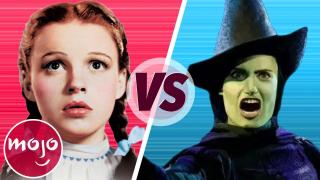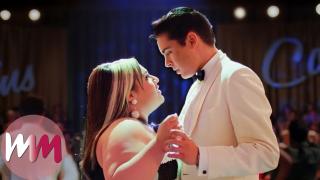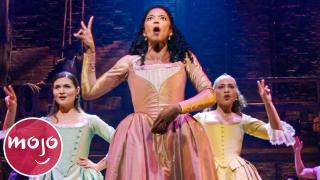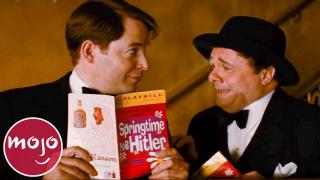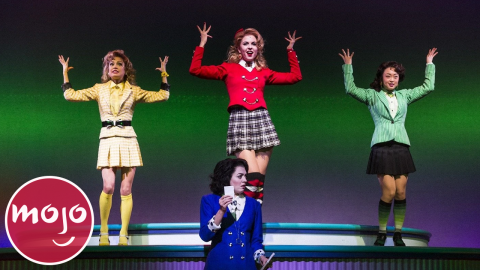Top 20 Most Iconic Musical Reprises
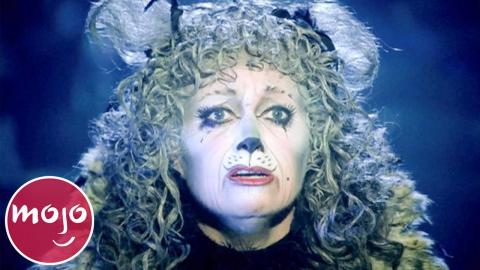
#20: “Dulcinea (Reprise)/The Impossible Dream (Reprise)/Man of La Mancha (Reprise)”
“Man of La Mancha” It’s kind of genius to have a reprise of your best songs at the end of a show. The audience will certainly leave the theater humming one of them. “Man of La Mancha” ends with the mad knight errant, who has been mocked and laughed at by virtually everyone he meets, on his deathbed. He is surrounded by his faithful servant and the lowly scullery maid he treated as a lady of honor. They sing reprises of his songs to remind the depressed and dying man of his quest to bring chivalry back to the world. Despite his death, his belief in goodness and honor has clearly rubbed off on his companions.
#19: “Stay Alive (Reprise)”
"Catch Me If You Can" a.k.a How To Stay Ahead Of The Competition
“Hamilton” As in many musicals, the characters in “Hamilton” are often associated with specific songs. “The Story of Tonight” and its reprise deal with Alexander Hamilton’s disagreements with Aaron Burr. “What Comes Next” features a brief reprise of King George III’s song about American independence. But “The Story of Tonight” is a special case. Though the actor is the same, he plays two different characters to whom Hamilton gives advice before a duel. His son dies as a result of his duel, and the words he spoke to his good friend come back to haunt him as he and his wife watch their son take his last breaths.
#18: “The Song That Goes Like This (Reprise)”
Top 10 Iconic Musical Theatre Costumes
“Spamalot!” Given that it’s a Monty Python musical, it’s safe to expect that it’s going to be pretty nutty. “The Song That Goes Like This” takes aim at the kind of sentimental, inspirational songs you’d hear in other, typical musicals. The Lady of the Lake returns to sing the song again in the middle of the celebratory “Knights of the Round Table” number. She pulls out every trick she knows. She does her runs, she rushes the tempo, she slows it down to a crawl. You’re practically dizzy by the end of it. And then the scatting starts. Her liberties with the melody, along with her glitzy and revealing ensemble, take the number to unexpected heights of complete lunacy.
#17: “38 Planes (Reprise)”
Top 10 Most Iconic Broadway Performances of All Time
“Come From Away” “38 Planes” follows the dozens of commercial airplanes that had to descend on the unassuming town of Gander in Newfoundland and Labrador after being diverted from their flight paths by the 9/11 terrorist attacks. The company of “Come From Away” chants the lyrics as the number of planes touching down only grows. When the song reappears at the end of the show, it sounds much the same, but is filled with even more meaning as passengers finally return home. It’s not just an emotional bookend to the characters’ brief but profound time together. It’s also a reminder of how each of those planes carried someone with a story, even if the show only tells a handful of them.
#16: “Not a Day Goes By”
Top 10 Iconic Broadway Dance Numbers
“Merrily We Roll Along” Although it was almost universally panned by critics when it opened, this Stephen Sondheim musical offers an unconventional narrative structure. Telling the story of a damaged friendship in reverse, the score of “Merrily We Roll Along” relies on callbacks and reprises throughout the show. “Not a Day Goes By” returns during the scene set at Frank and Beth’s wedding, as Mary watches a friend marry another woman. Given the context of Mary’s tempestuous relationship with Frank in the first act, it allows us to see the root of her disappointment in him. It’s an aching song, full of bitterness and longing made all the more urgent in its second appearance in the score.
#15: “Epilogue: Ragtime (Reprise) / Wheels of a Dream (Reprise)”
“Ragtime” This historical epic begins with a fittingly ragtime-inspired prologue that introduces each of its colorful turn-of-the-century characters to the audience. After much tragedy and growth, the ending mirrors its beginning, but closes out with a sweeping reprise of “Wheels of a Dream.” Sung by two lovers who died at the hands of a prejudiced society, the song represents their dream of the better America they hope their son will grow up in. The soaring tune closes the show, which is as much about how flawed America is as a nation as it is about how it has the potential to be better.
#14: “Wicked Little Town (Reprise)”
The Wizard of Oz VS Wicked
“Hedwig and the Angry Inch” Originally workshopped in grungy rock venues in New York City, “Hedwig and the Angry Inch” is a vibrant show about trauma and transformation. Hedwig Robinson is a drag artist whose songs have been stolen by the man she loves. He becomes famous, while she falls into bitter obscurity. At the end of the show, the performer playing Hedwig transforms into the rockstar she loves before our eyes. The character offers Hedwig the closure she needs, turning the song she wrote about him into a stunning number about searching for meaning in yourself and not others. By the end, Hedwig is exhausted but free.
#13: “Finale: The Old Red Hills of Home”
Top 10 Best Musical Finale Songs
“Parade” Jason Robert Brown’s score for “Parade,” a dramatization of the unfair trial and devastating murder of Leo Frank, a Jewish factory superintendent wrongfully accused of a heinous crime. The show opens and closes with the song “The Old Red Hills of Home,” a Civil War pastiche. Its description of the pre Civil War South is a resounding and chilling reminder that not much had changed in the years between the war and the antisemitic campaign against Leo Frank. It’s practically impossible not to feel goosebumps when the opening song comes back around to haunt us in the end.
#12: “Somewhere That’s Green (Reprise)”
Top 10 Green Characters
“Little Shop of Horrors” Seymour the timid flower shop employee has traded in his morals for fame and the girl of his dreams, all thanks to an exotic, man-eating plant. But the tables turn in the last act, when the plant ends up mortally wounding Audrey, his now fiancée. As she dies, Audrey reprises her tender and beloved song about the perfectly ordinary suburban life she’s always longed for. Her realization that she and Seymour can still have that if he feeds her to his plant is absurd and poetic. Even the most ordinary life is out of her reach.
#11: “I’m Not That Girl (Reprise)”
Top 10 Best Girl Power Broadway Songs
“Wicked” The complicated friendship at the heart of “Wicked” is tested by a few challenging circumstances. Apart from their clashing wardrobes and political extremism, Glinda and Elphaba have feelings for the same guy. But when it becomes clear that Elphaba is the one he loves, Glinda’s take on her song, “I’m Not That Girl,” becomes a short but poignant emotional counterpoint. It’s the tipping point for her. Glinda’s come a long way from being the popular girl at Shiz Academy who was sure to have a happy ending. Now, she’s not sure who she is.
#10: “Johanna - Quartet”
“Sweeney Todd: The Demon Barber of Fleet Street” With the murderous barber’s deadly revenge plot in motion, the eerie love song performed by Anthony in the first act reappears. The various plotlines in the musical unfold in this reprise. Characterized by starts and stops as the perspective shifts, Sweeney expresses his grief over his lost wife and daughter, who he doesn’t realize is living in the sadistic Judge Turpin’s house. He also doesn’t realize the woman Anthony is in love with is his daughter, Johanna, who in turn is being driven mad by her captivity in an asylum. The Beggar Woman shouting that the city’s on fire just adds to the suspense. If everyone could talk to each other, the whole thing could be figured out. But that’s what makes good drama.
#9: “Do You Hear the People Sing? (Reprise)”
Top 10 Broadway Songs You Can't Sing In Public
“Les Misérables” Jean Valjean’s journey from a lowly prisoner to a fugitive from the law to a noble and honest Christian is finally complete. On his deathbed, he is guided to the afterlife by every character who died during the show. In “Les Misérables,” that’s about the population of a small country. The song’s revolutionary anthem, “Do You Hear the People Sing?” rings through the rafters as Valjean joins them on the other side. Though the lyrics originally described a better world for the poor and destitute of France, it takes on a new and haunting meaning in the finale. The better world, it turns out, would not be found on earth, but in the afterlife.
#8: “All I Ask of You (Reprise)”
Ranking ALL the Songs from the Mean Girls Musical
“The Phantom of the Opera” Terrorized once again by the Phantom who is obsessed with her, Christine flees to the roof of the Paris Opera and her admirer, Raoul, pursues her. But the Phantom appears after they profess their love to one another and exit. Heartbroken, then burning with rage, the Phantom swears bloody revenge on both. This culminates with the Phantom’s sabotage of the huge chandelier in the theater. The tone of the show changes completely in this one moment. What starts out as a gothic mystery about an obsessive romance becomes a game of cat and mouse between the Phantom, Raoul, and Christine.
#7: “Climb Ev’ry Mountain (Reprise)”
“The Sound of Music” Maria does what any of us would do if we thought we were in love with someone. She flees the scene. But the novice nun’s mentor, the Mother Abbess, convinces her to face her feelings with a rousing song about reaching your dreams. “Climb Ev’ry Mountain” reappears at the triumphant finale, as Maria and the Von Trapp Family escape from the Nazis and cross the Alps into Switzerland. In the show, the nuns form a chorus and reprise the Mother Abbess’s song. In the 1965 film, it’s sung by a chorus of singers in voiceover. But no matter who sings it, the tune that scores the family’s triumph is a profoundly moving and uplifting note to leave on.
#6: “Tonight Quintet”
“West Side Story” Tony and Maria’s driving song after their romantic meeting on the fire escape comes back at the end of the first act, when all the characters’ destinies are colliding. “West Side Story” is a musical all about competing desires. The Jets and the Sharks want nothing more than to obliterate the other. Tony and Maria want to be together, despite their different backgrounds. Maria’s brother, Bernardo, and his girlfriend, Anita, want to protect his sister. The “Tonight Quintet” dramatizes these competing forces in this explosive reprise, with five timelines converging on the potentially deadly rumble between the gangs.
#5: “Memory (Reprise)”
What If We Didn't Have Memory? | Unveiled
“Cats” If you’re only familiar with this long-running musical’s biggest number, you might be shocked to learn the most popular version of it is technically the reprise. The mournful ballad is first heard at the end of act one, but reappears at the end of the show when Grizabella the Glamour Cat makes her last plea to be accepted by the other Jellicle cats. Her song is so moving that she is chosen among all her fellow cats to journey to the mystical Heaviside Layer. “Memory’s” lyrics of woe and faded youth are stirring, and they leave plenty of room for interpretation from performer to performer. It’s also one of the few songs in the show that allows for real depth of feeling.
#4: “One (Reprise)”
Top 20 Iconic Broadway Dance Numbers
“A Chorus Line” Throughout the classic Tony-winning musical, we meet several dancers auditioning for a chance to be in the ensemble of a new show. Their stories of what they sacrifice for their dancing are funny and heartbreaking. However, it’s hard to say how happy the ending is for those who are cast. At the end, as the reprise of “One” plays out, each individual dancer becomes swallowed up by the whole. Their bodies, and identities, become lost on stage. Despite being such distinctive personalities before, we realize they’ve been fighting for a chance to become a part of one indiscernible mass.
#3: “You’ll Never Walk Alone (Reprise)”
All the Heathers: the Musical Songs: RANKED!
“Carousel” One of this controversial musical’s most memorable songs, “You’ll Never Walk Alone,” is a tearful reminder of hope, compassion, and connection in troubled times. Its first appearance in the show is effective, sung when the callous carnival barker Billy Bigelow dies in a robbery attempt. But the reprise at the end of the show tugs even harder at the heartstrings. Forced to watch his child grow up in a shadow of shame, Billy’s spirit is only able to find peace when he helps his daughter see that she can depend on others. Its emotional reprise is a big reason why the song is still a standard today.
#2: “I’ll Cover You (Reprise)”
Top 10 Most Important LGBTQ+ Musical Theatre Moments
“Rent” Originally presented as a touching but hilarious love song between Collins and Angel, “I’ll Cover You” is essentially their vows to each other. Once Angel dies in the second act, the song comes around again as Collins grieves the life they might have had. Though he’s surrounded by the rest of their friends during the scene, he still somehow seems so alone as he repeats the promises they made to each other. What was once an upbeat pop song turns into a downtempo, soulful ballad, nested inside a reprise of the show’s signature number, “Seasons of Love.” Before we unveil our top pick, here are a few honorable mentions.
“Everybody’s Got the Right (Reprise),” “Assassins”
Top 10 Iconic Pop Culture Moments of Each Year (2000-2009)
A Group of Malcontents Explains Their Reasons for Turning to Political Violence
“As Long As He Needs Me (Reprise)” “Oliver!”
Top 10 Iconic Mary-Kate & Ashley Fashion Moments
The Hopelessly Devoted Nancy Makes a Sacrifice
“How to Wash a Check (Reprise)” “Kimberly Akimbo”
Top 20 Hardest Female Musical Roles
A Group of Unlikely Teenage Criminals Go Over Their Scheme
“The Beauty Is (Reprise),” “The Light in the Piazza”
Top 10 Dark Truths About the Beauty Industry
An Overbearing Mother Has a Change of Heart
“Road to Hell (Reprise),” “Hadestown”
Top 10 Road Trips in Australia
This Song Ends the Show Back Where It Started, Telling the Same Story Forever
#1: “Sunday (Reprise)”
“Sunday in the Park with George” The song “Sunday” first appears at the end of act one, as the painter Georges Seurat arranges the ensemble into a tableau of the famous painting that inspired the show. It’s a haunting, echoing piece of music that ranks among composer Stephen Sondheim’s best. Staging the show’s themes of immortality through art, the final number sees the characters from the first act return to resume their positions in the painting. Once again, the artist creates harmony and perfect balance in the world through his painting as the song echoes through the theater, seeming to go on forever.



